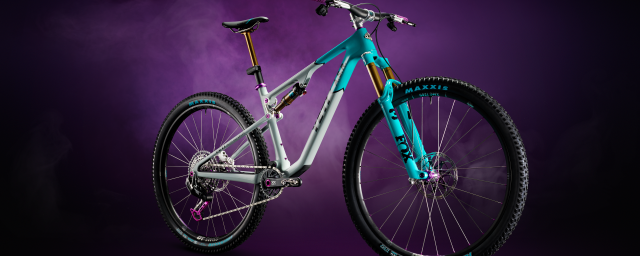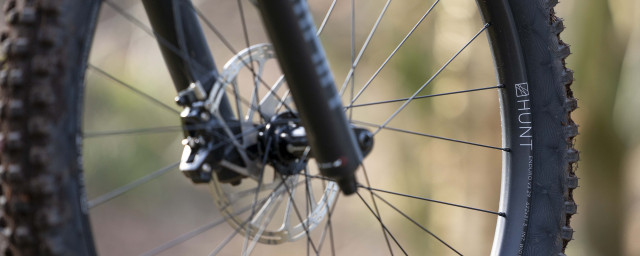Mountain bike tyre inserts - everything you need to know

Despite the tyre industry's enormous resources, the best mountain bike tyres have always been the primary candidate for mechanical failure during a ride. Punctures. Pinch flats. Sidewall cuts. It doesn’t matter how those sniper-roots or sharp rocks compromise your tyre casing, the result is most certainly disappointment.
- Best trail and enduro mountain bike tyres you can buy - tried and tested hard hitting rubber
- Tubolight EVO HD tyre insert review
- Schrader vs Presta – which valve standard is best for you?
Mountain bike tyres have improved. The standardisation of tubeless tyre technology, wider rims and larger casings have made tyres more robust. But they've also become heavier, with designers adding material and structural layers of protection to increase durability. The problem is that even tyres heavier than the psychological 1,000g still suffer pinch flats.
Why are pinch flats such an issue in mountain biking?
As frame design and suspension technology improve, riders roll into more challenging trails and sending more prominent features. The pinch flat correlates to choosing and rolling the most adventurous lines on any downhill trail. If you rush through high-speed rock gardens and rooty sections, you’ll compress that tyre casing against the rim bead and trigger a pinch flat.
The rise of the mountain bike tyre insert
Mountain bike wheel designers have tried to mitigate the risk, with a new-generation of rims featuring wider beads to dissipate the point loading on impact. It might only be a few millimetres more material, but it does make a difference. But pinch flats still happen when landing a big jump, drop-off, or speeding across a jaggedly rocky section of trail.
The mountain bike industry's response has been tyre inserts. Made from closed-cell foam, the insert mounts between your tyre and rim, adding all that cushioning you require to avoid getting a pinch flat, no matter the terrain you ride.
Tyre inserts might look deceptively simple to the untrained eye, but there’s quite a bit of design integration that makes them function poperly. The first challenge is packaging. Any mountain biker who has suffered the frustration of trying to seat a moody new tubeless tyre, that Friday evening before a weekend ride, will know that much profanity and painful fingers can ensure.
The tubeless tyre interface works on tight tolerances to ensure secure air retention. Adding a tyre insert into that interface requires a precise understanding of the relationship between a tubeless rim and tyre. It is not simply the case of cutting some closed-cell foam into a shape that resembles the dimensions of your mountain bike’s rims.
Mountain bike inserts save your tyres – and carbon wheels
Some of mountain biking’s most established rim and tyre brands - cSixx, Schwalbe, and Vittoria – market precision tyre inserts, meticulously engineered to work with a diversity of rim and tyre sizes. You can also choose dedicated tyre inserts companies such as Huck Norris or CushCore.
Aside from preventing the annoying pinch flats that ruin your trail or enduro ride, what are the other benefits of using tyre inserts? By implication of protecting your tyres from pinch flats, inserts also guard against rim damage. Aluminium rims can be fragile to rock and root impacts, disrupting the bead shape and compromising the ability of a rim to seal with tubeless tyres.
The protection element of tyre inserts is even more valuable for riders rolling expensive carbon-fibre wheels. Carbon rims are a lot tougher than aluminium, but they can be vulnerable to acute point-loads on the bead, which is exactly the impact distribution dynamic of a pinch flat. With tyre inserts in place, you dramatically lower the risk of a punch-flat type impact, cracking that carbon rim.
Mountain bike inserts improve confident cornering
Beyond enhancing the durability and impact-strike survivability of your tyres and rims, using inserts can have dynamic riding benefits, too. Inserts add additional material around the bead of your rims, where initial tyre lean and casing squirm happen during high-speed cornering.
With tyre inserts in place, there is more structural support for your tyres, theoretically enabling more extreme lean angles and higher cornering loads without the risk of your tyre burping off the rim.
Trail and enduro mountain bikers, who frequently ride technical terrain and never avoid the most challenging descents, know the value of lower tyre pressure.
An overinflated tyre becomes impossible to control and steer accurately across technical trail features like rocks and roots. Instead of absorbing and shaping with the terrain you are riding, overinflated tyres will deflect off trail ‘texture’ and render a wayward interpretation of your chosen lines and riding intention.
Lower tyre pressures allow for the tyre casing to shape and absorb terrain. And with inserts, you can run even lower pressures without the risk of pinch flats or a tyre unseating from the rim.
Mountain bike tyre inserts - the rotational weight debate
If tyre inserts save your rims from damage, prevent the disappointment of a ride interrupted by pinch flats and support better cornering performance, why doesn't everyone use them? The answer is simple, aligned to the philosophy of primary consideration in all things cycling: weight.
Tyre inserts add weight, and although it might not register as much (averaging between 140-250g), the issue is that inserts are rotational weight. And as riders know, any component that rotates exerts a much greater fatigue burden when grams are added.
Statistically, the weight you add with tyre inserts can equal the difference between upgrading from aluminium to carbon rims. In the context of mountain bike wheelset comparisons, where the sensitivity to rotational mass is very real, adding 200g inserts might be an issue for many riders. Especially if you regularly pedal long rides and do a lot of climbing.
If you regularly ride technical trails, never shy away from rolling off a drop, or steering over the most intimidating rocks, gardens, or root sections, tyre inserts are recommended. The best unit of analysis is to evaluate how many pinch flats you’ve suffered.
If your local trails and riding style are causing pinch flats, get some inserts because mountain bike tyre technology will not make a breakthrough soon, resolving the pinch flat issue without inserts. And a tyre insert is much cheaper than a replacement carbon rim.













1 comments
I have been riding offroad with Tannus Amour for a number of years, never had a sinlge puncture and I have to remember to swap out innertubes every few years because they rot in the bad weather, especially around the valves.